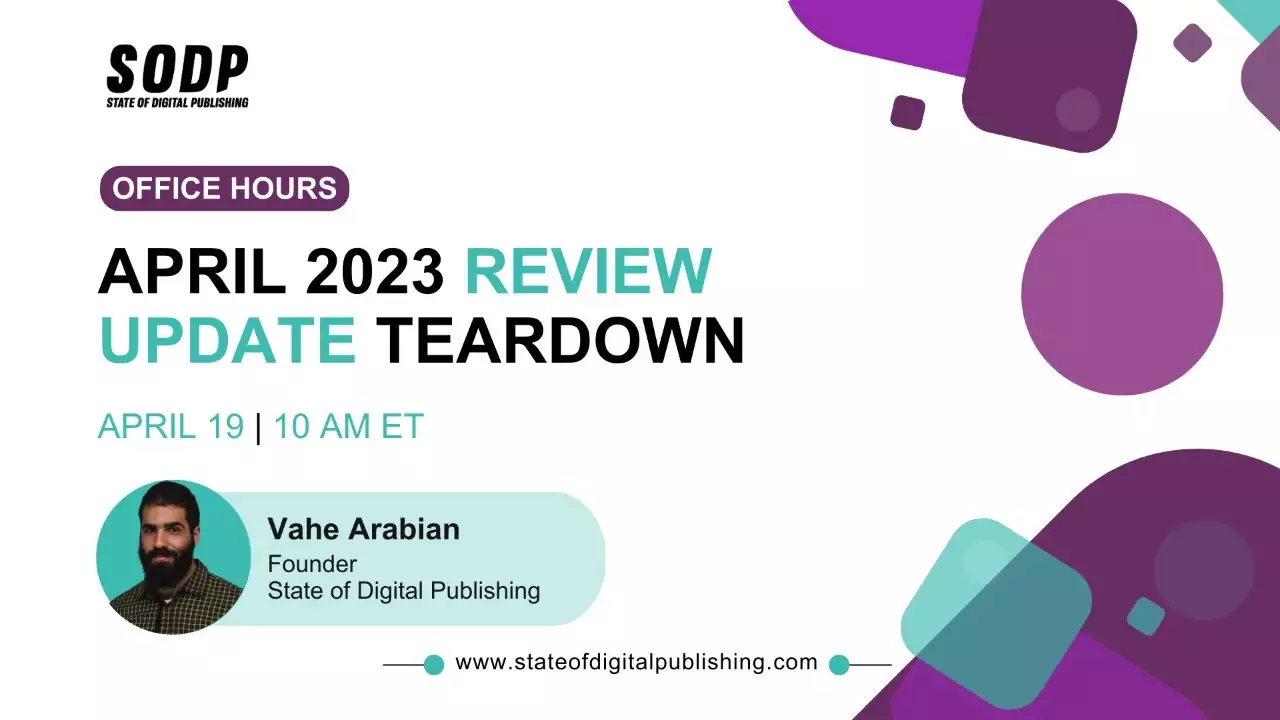Office Hours
Join us as we discuss short-form videos, Meta’s plans to pivot as it sees more user engagement for news publishers, and successful web story examples that you can use to benefit your news SEO today.
About SODP
State of Digital Publishing (SODP) is a hybrid publisher and consultancy for publishing brands, helping them build sustainable business models for long-term growth.
SODP’s social memberships grant access to our one-on-one support, insights, and data, as well as our Content Cluster Strategy Toolkit that provides step-by-step instruction on how to develop effective content pillars.
You can become a member today at $39 per month, or secure a 30% discount on the monthly price with a yearly subscription. Get access to all webinar recordings, exclusive industry insights, and more with SODP membership.
Agenda
- How to use Web Stories to improve your news SEO
- Best practices while determining the format
- How to maximize user engagement
- How Meta’s pivot towards short-form videos will impact digital publishers
In this episode, we discuss why short-form videos and Web Stories have a greater impact and why they are the major focus for 2022. We’ll also review a few case studies of Web Stories we tested in the past couple of months and share their results.
While doing this, we’ll provide you with an idea about how to make the most out of Web Stories, particularly from a news perspective, and explain the best practices when it comes to maximizing engagement as well as determining the best format for your content.
Meta’s Pivot Towards Short-Form Videos
According to various reports, Meta is reallocating its resources (paywall) from its news products to encourage other creative initiatives. As a result, it’s massively focusing on updating its algorithm to compete with emerging social sites, such as TikTok.
Facebook wants to ensure that it can evolve to match the next generation of social media users and Web 3.0.
Poor user attraction to Facebook’s mainstream news link over the years could be one of the primary reasons behind the social media giant updating its approach. Additionally, there has been a shift in consumer behavior with regard to video engagement.
This shift in online consumer behavior has helped social media like TikTok become mainstream and even attract a bigger portion of the new generation of social media users. This brings us to our topic of the day: Web Stories.
What are Web Stories?
Web Stories are Google’s version of interactive content and short-form videos, similar to Facebook Story, TikTok videos and Instagram Reels videos. Google uses its AMP technology to deliver web stories. They also appear in the Discover and Stories section of the Google app.
Web Stories have been in use for a few years now, but why are we talking about it in 2022, and why do we think it’s a priority now?
It’s because Google is testing it a lot more on their search results, and Web Stories are actually beginning to appear on the search engine results pages (SERPs). It’s not just us, other industry leaders are also seeing them appear on top now.
Professionals like John Shehata and Brodie Clarke have already demonstrated the impact of Web Stories in their case studies. They have been able to test and rank their Web Stories at the top of the SERPs.
With all this in place, we believe in incorporating effective tools at an early stage — when there’s less competition — before everyone uses and abuses them.
Why 2022 Is the Year for Web Stories
Google has been focusing on and testing short-form videos extensively since March, and according to Glenn Gabe, another search engine professional, Web Stories and short-form videos from social sites like YouTube and TikTok are showing up in the Web Story areas of SERPS. This is an indicator that Web Stories are already starting to make a huge difference.
We think it’s the perfect time for us to test the impact and help our partners incorporate these strategies for an effective outcome.
A lot of big publishers are already creating Web Stories to target Gen Z and younger audiences now that Google Ad Manager and AdX fully integrate with Web Stories. They can be linked to the desktop version of web pages.
For instance, The Australian has a section at the top of their home page that displays Web Stories. It was time for us to figure out whether it works as well for small and medium-sized publishers.
Our Experiment and Findings
We began testing Web Stories back in April, primarily for three of our client’s websites that focus on cryptocurrency, WWE and entertainment, and puppy resources respectively. Since we have customers in the B2B niche as well, we also tested a website that focuses on business news coverage.
While we were able to pull some pretty good results for the first three websites, we unfortunately didn’t see the same positive results for the fourth website. This was the result of us not strictly following best practices and serves as an important lesson.
Here’s a brief overview of our progress with the first three sites.
We consistently published Web Stories in listicle format on the puppy resources website throughout May, which resulted in a traffic spike. The website experienced a visitor drop as we slowed the process the next month.
With the crypto website, on the other hand, we focused on long-form content, news recaps and cryptocurrency predictions. We found out that the long story pages didn’t perform as well as other forms of content.
We created and published quite a few news stories for the WWE and entertainment website. Not only that, but we also linked the news stories to other stories on the website.
While frequently publishing news in the form of Web Stories, we experienced a spike in the number of website visitors. For instance, we published a story about the departure of Paige (a high-profile WWE wrestler) from the organization. It helped the website’s number of visitors exceed 7,000.
We experimented with educational, listicle and news content recaps and noticed that
- Listicles performed the best
- Linking from the main site increased the performance of Web Stories
- Frequency and cluster were one of the major driving factors.
While unable to create video content for these clients, as they wanted to test things quickly, it was a fascinating find.
Finally, we discovered that these publishers could have attracted more traffic if they had published more.
For instance, we created and published 54 stories for the puppy resource website within a six-week period. It received more traffic in comparison to the other two websites that published just under 20 pieces over three months.
The Best Practices
Google has its web stories hub where you can examine the individual case studies of big publishers and the formats they prefer publishing.
Google suggests:
- Prioritizing videos when it comes to publishing Web Stories since they bring more engagement
- Focusing on making the videos shorter than 15 seconds
- Adding video captions to make the content more discoverable.
For those looking to test or implement Web Stories, we suggest planning a video-first strategy because it should generate the most engagement. Additionally, try to match visitor search intent whether creating a Q&A or listicle story.
Most importantly, don’t make random (clickbait) content just for the sake of publishing as such content might not work.
Taxonomy is important because of the WordPress plugin. Even when not using WordPress, creating a cover page and stories poster — or a thumbnail — is essential.
Putting a logo in a particular size is highly suggested to ensure it shows up in search results properly. Additionally, word count also matters, and it’s recommended that every story page is at least 40 words but not more than 70.
It’s easy to be left wondering how to proceed ASAP. Well, it’s not necessary to jump into the publishing phase, when testing is always an option . Google provides AMP testing tools, to ensure a strategy works before its implementation.
The Workflow
It’s easy to publish Web Stories on WordPress with plugins. However, for those not using WordPress, Newsroom AI or Make Stories are an alternative. The first step is choosing a visual editor.
After choosing the editor, the next step is to draft the story. Always ensure a template is handy before publishing, as this speeds up the publishing process.
In the next step, sourcing creative assets — particularly videos — is important. This is followed by SEO activity to help maximize the content’s reach and click-through rate (CTR).
Once content has been prepared and optimized, it can be published from the CMS backend. After publishing, consider monetizing it using an ad network.
Q&A
Alex Moritz:
If we were to approach stakeholders reluctant to try something new and untested in their worlds, though we have the data to prove it works, what do you suggest is the best publishing strategy in terms of what and how many stories should be released at a specific time (otherwise they’ll fail to be visible)?
Vahe Arabian:
Based on the initial data that we have, I suggest having enough resources to cover a consistent amount of publishing within a period. Additionally, as videos have more engagement, investing in resources, such as video editors, to create frequent videos is recommended.
If you analyze the results on tools like SEMrush and Ahrefs, you can find a lot of publishers, especially your competitors, who are using Web Stories. You can refer to their activities and create a plan with your team. You can also allocate your budget to offer the stakeholders some valuable stuff for free.
Adding to the previous SEO discussion, TikTok is now focusing on basic SEO fundamentals. It hints at a huge growth opportunity for publishers and marketers.
Alex:
When you were performing these tests, did you focus on giving your stakeholders the right set of information so that it could be consumed and spread, or was it just a blind test with no marketing value?
Content from our partners
Vahe:
We focused on the best marketing practices with all three tests. We also adhered to essential creator guidelines and best SEO practices. However, we also did a few things differently while doing these tests. For instance, while publishing content for the puppy resources website, we also tested if linking from the website was beneficial. As a result, we noticed the attraction of traffic to the website because of this very reason.
To answer your question precisely, we didn’t make a direct push on the promotional side but incorporated all the necessary practices essential for great marketing while testing new things as well.
Office Hours Registration Question:
How can we trigger Top Stories with Web Stories?
Vahe:
First, it’s important to focus on a niche and plan a news-cluster strategy. If we take an example of one of our recent tests, one of the stories we published for the crypto website was titled “How Binance locked out users”. The story was one of the major reasons behind the spike in the number of visitors. The fact that we covered the story well helped attract new users.
The key takeaway is to be very concise and specific about the question you are willing to answer with your story.
Additionally, there are tools that help you score better results. For instance, Google’s Question Hub might be an extremely useful tool if you’re based in the US and a few other countries it’s currently available in. It shows you unanswered questions that people ask on search engines frequently.
Imagine being able to identify the content gaps and creating specific content for your readers. It’s a highly recommended tool for US users. If you’re outside the US, it’s not available for you at the moment. However, you can submit your email there and Google will inform you when it’s available in your region.
Alex:
What is the format of code behind the Web Stories? Are they standard codes or are they in AMP format?
Vahe:
The WordPress plugin uses AMP format since it’s from Google.












